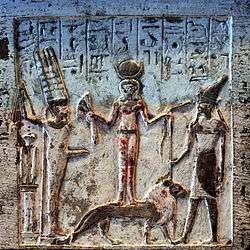Resheph

Resheph (also Rešef, Reshef; Canaanite ršp רשף; Eblaite Rašap, Egyptian ršpw) was a deity associated with plague (or a personification of plague) in ancient Canaanite religion. The originally Eblaite and Canaanite deity was adopted into ancient Egyptian religion in the late Bronze Age during the Eighteenth Dynasty of Egypt (late 15th century BC) as a god of horses and chariots.
In Biblical Hebrew, רֶשֶׁף resheph is a noun interpreted as "flame, lightning" but also "burning fever, plague, pestilence".[1]
Ebla
The name is found in the third millennium tablets from Ebla, as Rašap (Ra-ša-ap), listed as divinity of the cities of Atanni, Gunu, Tunip, and Shechem. Rasap was also one of the chief gods of the city of Ebla having one of the four city gates named in his honor.[2]
Ugarit
Ršp was an important Ugaritic deity. He had the byname of tġr špš "door-warden of the Sun".[3] Sacrifices to Ršp (ršp gn) were performed in gardens.[4][5]
Ugaritic Ršp was equated with Mesopotamian Nergal.[6] Fauth (1974) argued that ršp in the later Canaanite period no longer referred to a specific god and could be used as a byname, as in Rešep-Mikal at Kition.[3] Teixidor (1976) based on an epithet ḥṣ in Kition (interpreted as "arrow") identifies Ršp as a plague god who strikes his victims with arrows as Homeric Apollo (Iliad I.42–55), and argues for an interpretatio graeca of Ršp with Apollo in Idalium.[7]
Resheph is mentioned in Ugaritic mythological texts such as the epic of Kirta[8] and The Mare and Horon.[9]
Although the iconography of Resheph shares the gazelle with that of the Egyptian-Canaanite Shed, Cornelius (1994) writes that "the rest of the attributes are totally different."[10]
Egypt
Resheph was adopted as an official deity in Egypt under Amenhotep II during the Eighteenth Dynasty of Egypt as god of horses and chariots. Originally adopted into the royal cult, Resheph became a popular deity in the Twentieth Dynasty while disappearing from royal inscriptions. In this later period, Resheph often appears with Qetesh and Min. In this time, however, most his stelae are found in Deir el-Medina, a settlement of Syrian (Levantine) craftsmen.
The theonym is usually written as hieroglyphic ršpw, where the final -w is added in analogy to other Egyptian divine names.[11]
Hebrew Bible
In Biblical Hebrew, resheph רֶשֶׁף means "flame, firebolt", derived from שָׂרַף "to burn".[12] Resheph as a personal name, a grandson of Ephraim, occurs in 1 Chronicles 7:25.
In Habakkuk 3:5, describing the procession of Eloah (אֱל֙וֹהַ֙) from Teman and Mount Paran, mention deber and resheph as going before him, in the King James Version translated as "pestilence" and "burning coals". Due to the discovery of both deber and resheph as theonyms in Ebla, this passage has been reinterpreted as describing a procession of the retinue of El going to war with Yam.[13] In Job 5:7, there is mention of the "sons of resheph", translated in the Septuagint as νεοσσοὶ δὲ γυπὸς "the young of the vulture"[14] and in the King James Version as "sparks".
See also
Notes
- ↑ רֶשֶׁף in Gesenius, Hebrew Lexicon.
- ↑ Giovanni Pettinato, The Archives of Ebla: An Empire Inscribed in Clay. Doubleday & Company, Inc., 1981 ISBN 0-385-13152-6
- 1 2 Wolfgang Fauth: Rezension von: Wolfgang Helck: Betrachtungen zur Großen Göttin und den ihr verbundenen Gottheiten. In: Gnomon. 46.7 (1974), p. 689.
- ↑ Wiseman, D. J. (23 December 2013). "Mesopotamian Gardens". Anatolian Studies. 33: 143. doi:10.2307/3642702.
- ↑ Studi semitici, 1981
- ↑ Barré, M. L. (1 January 1978). "dLAMMA and Rešep at Ugarit: The Hittite Connection". Journal of the American Oriental Society. 98 (4): 465–467. doi:10.2307/599760. JSTOR 599760.
- ↑ Teixidor, Javier (1 January 1976). "The Phoenician Inscriptions of the Cesnola Collection". Metropolitan Museum Journal. 11: 65. doi:10.2307/1512684. JSTOR 1512684.
- ↑ tablet 1/CAT 1.14, column 1, lines 18-20; tablet 2/CAT 1.15, column 2, line 6
- ↑ CAT 1.100, lines 30-31
- ↑ Cornelius, Izak (1994). The Iconography of the Canaanite Gods Reshef and Baʻal: Late Bronze and Iron Age I Periods (C 1500-1000 BCE). Vandenhoeck & Ruprecht. p. 16. ISBN 978-3-7278-0983-5.
- ↑ Reshef, Encyclopedia of Religion (2005).
- ↑ Strong's Concordance H7565
- ↑ John Day, "New Light on the Mythological Background of the Allusion to Resheph in Habakkuk III 5", Vetus Testamentum 29.3 (1979), 353–355.
- ↑ Dunham, Kyle (2016). The Pious Sage in Job: Eliphaz in the Context of Wisdom Theodicy. Wipf and Stock Publishers. p. 24, footnote 30. ISBN 978-1-4982-7459-3.
- Wolfgang Helck: Die Beziehungen Ägyptens zu Vorderasien im 3. und 2. Jahrtausend v. Chr., (Ägyptologische Abhandlungen, Band 5) 2. Auflage, Harrassowitz, Wiesbaden 1971 ISBN 3-447-01298-6 (Zu Reschef in Ägypten: S. 450-454)
- Lipiński, Edward. Resheph: A Syro-Canaanite Deity. Peeters, 2009. ISBN 978-90-429-2107-8.
- Münnich, Maciej M. The God Resheph in the Ancient Near East. Mohr Siebeck, 2013. ISBN 978-3-16-152491-2.
- Tazawa, Keiko. Syro-Palestinian Deities in New Kingdom Egypt: The Hermeneutics of Their Existence. British Archaeological Reports, 2009. ISBN 978-1-4073-0448-9.

